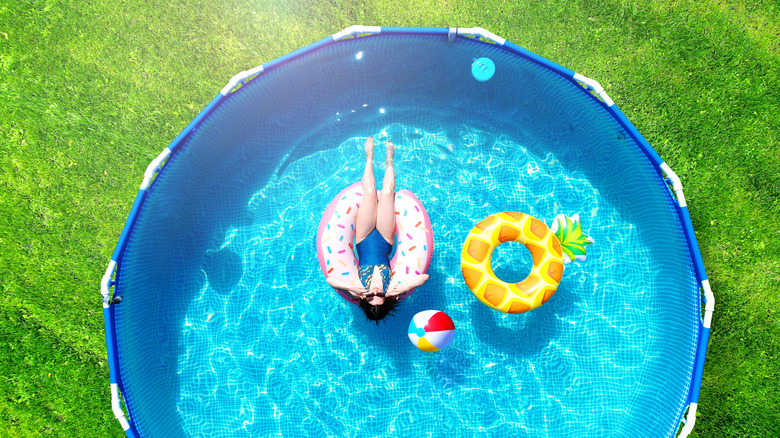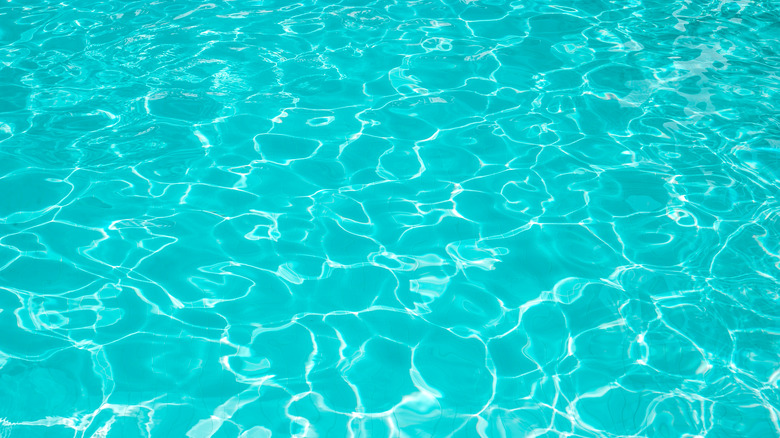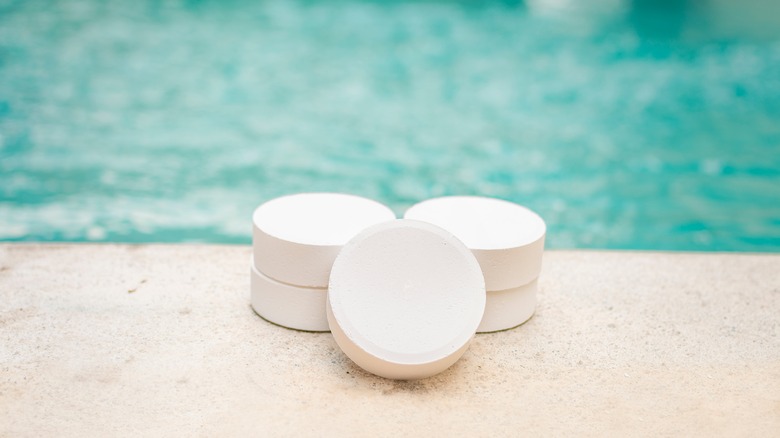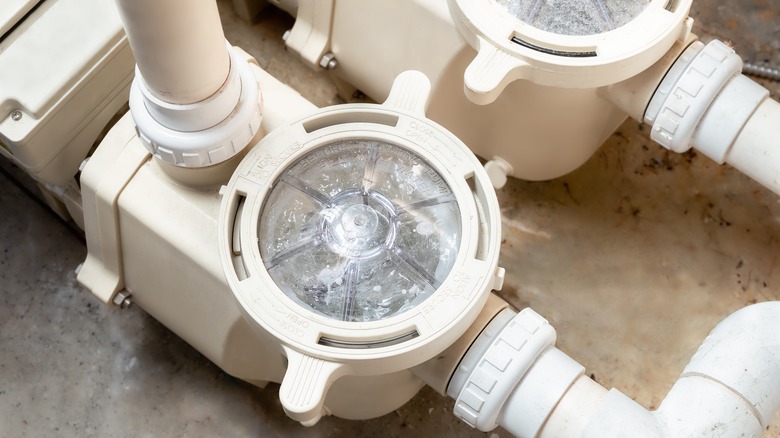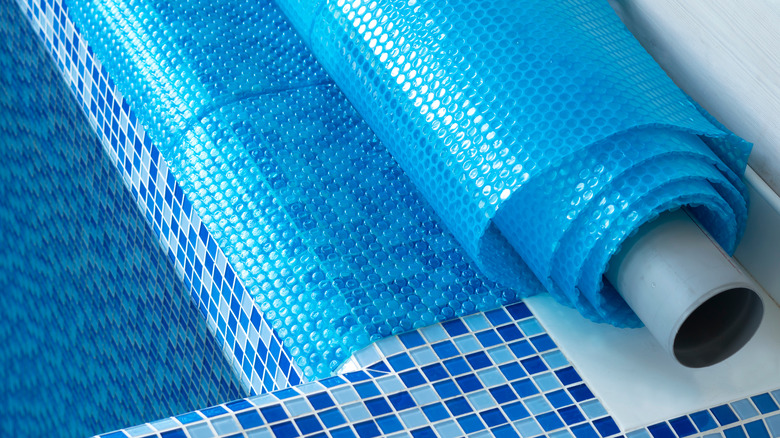How To Winterize Your Above Ground Pool
Winterizing an above-ground pool is a step that every homeowner with one of these features in the backyard must take. This process protects the amenity from damage that can occur when freezing conditions set in. Latham Pool notes that winterizing and closing a pool are completely different processes. A homeowner might close their pool down for a long weekend away or throughout the winter if they live in an area that isn't prone to freezing temperatures.
Closing a pool is the process of shutting off essential features (like the pool pump) and perhaps covering the body of water as a safety measure. Conversely, by winterizing your pool, you prepare the feature for disuse over a much longer period of time. In colder regions, a pool may not be used for four to six months of the year, and during this downtime, your water feature requires a precise closure process that will protect its delicate and critical internal components.
Winterizing might sound like a difficult task, but with the knowledge of what this process entails and accomplishes, you can streamline the process with ease on a yearly basis.
Tackle the project at the right time of year for your area
The first thing to note when approaching pool winterization tasks is that this must be done at the right time of year. Forbes Home reports that winterization should take place once the rough daily temperature in your community drops below 65 degrees Fahrenheit. The colder the better, though. starting the winterization process before the temperature has had a chance to begin dropping can create problems with growth in the pool water. You'll be adding chemicals and shutting down the systems that keep your pool water in constant motion. One thing that helps prevent the growth and spread of algae in a pool is the movement created by routine swimming and by the use of your pool pump to constantly rotate the water through the pool's systems (via Aiper). By turning these off and ceasing the regular use of the facility, you put the feature at risk for increased algae bloom and bacterial growth. Combined with warm temperatures, stagnant water acts as a breeding ground for these types of problems.
There is no set schedule for getting this process done — it is instead reliant on the particular weather conditions that occur during each new year and in every local community. Keeping an eye on the temperature will alert you to the appropriate time to begin your winterization project.
Clean the pool thoroughly
The first step that you must take is a thorough cleaning of the pool. The process of winterizing your pool acts as a means to protect the water, surfaces, and fixtures. For one thing, you'll be incorporating elements to help keep the water from freezing inside pipes and other elements. But this isn't the only aim of pool winterization. In addition to anti-freezing tactics, you'll need to prepare the aquatic environment for the natural lack of water flow.
This begins with a deep clean of the surfaces and water. Forbes Home notes that a pool cleaning starts with a visual inspection and an interrogation of the pool chemistry so that you can identify some of the more important action items and tackle them first. Then, it's important to place yourself at the water line and scrub along the entire length of the pool where the water level sits. Scrubbing this line will eliminate any existing growth where the air and water meet and set you up for success as you continue to go through the process of cleaning your pool.
After you scrub the sides of your pool, you'll need to catch any debris that may be floating on the water's surface with the basket, vacuum the pool floor, and potentially sweep a number of times to finish off the cleaning process. It's also important to remove any items that you may typically keep in the pool such as toys or a floating chlorine dispenser.
Balance your water chemistry with winterizing chemicals
Once the pool has been cleaned, it's time to add a few essential pool chemicals. In The Swim reports that chlorine-free pool shock, algicide, and stain and scale treatment are all important additions for homeowners looking to protect their pool throughout these winter months. Shocking the pool will keep your water in a state of quality equilibrium and help prevent the establishment of new algae or bacterial growth. These other pool chemicals also play a critical role in keeping your water properly balanced and ready for use as soon as the weather begins to turn again in the spring.
Adding pool chemicals is an important step because it will ensure that your water feature remains clear and comfortable, preventing a serious surprise when you open up the pool again a few months down the road.
Winterizing chemicals should be added to the pool based on the guidance printed on the outer package. It may also be a good idea to speak with professionals at your local pool equipment store to get a better sense of how homeowners in your local area have successfully dealt with winterization tasks in the past.
Take steps to protect the pump, skimmer, and filter
Another important step in winterizing your pool is the protection of your pump, skimmer, and filter. Ideally, you'll be able to drain the water completely out of these systems. Removing the water from your pump and other water maintenance systems protects these features from the matter change that happens when water freezes. As water freezes, it expands, and in confined spaces, this can result in disastrous damage that may require expensive repairs before the pool can get back up and running in the spring. Protecting these systems is a core component of the winterization process that homeowners must go through.
It is possible to simply drain all of the water from your pool in order to protect it during a particularly cold winter period; however, draining your pool will inevitably require you to refill it. The pool holds an enormous volume of water and refilling it from empty can be an immensely costly proposition that essentially precludes this approach as an option. 1st Direct Pools also notes that this can cause cracking in the pool, leading to a greater level of hazard than this step is typically worth.
Alternatively, if you aren't able to completely drain the water, then adding an antifreeze chemical (a non-toxic version, not the type used in other home applications) can provide the necessary protection as the temperature drops.
Cover your pool and install an ice equalizer
The last thing you'll need to do to protect your pool from the winter chill is apply a covering to the water's surface. A pool cover will protect your pool water from the introduction of bacteria and debris that can occur naturally when the water surface is exposed to the air and environment around it. A pool cover will regulate the temperature of the water and help keep it from freezing overnight and evaporating throughout the day's sunlight hours; it also keeps the space darkened to prevent unwanted growth (via Dolphin Leisure).
As well as the cover for your pool's water, it's important to include an ice equalizer beneath the covering itself (via Robelle Industries). An ice equalizer acts like a pillow, lifting the cover up just slightly enough to prevent it from resting completely against the water beneath it. With the help of an ice equalizer, you can prevent the freezing and expansion that can happen during the most intense time of winter chill. This will keep the water from adding stress and pressure onto the walls and floor of your pool if the liquid does begin to freeze. These final steps will ensure that your pool remains protected throughout the winter and ready for use as soon as you want to jump in for a dip in the coming spring months.
